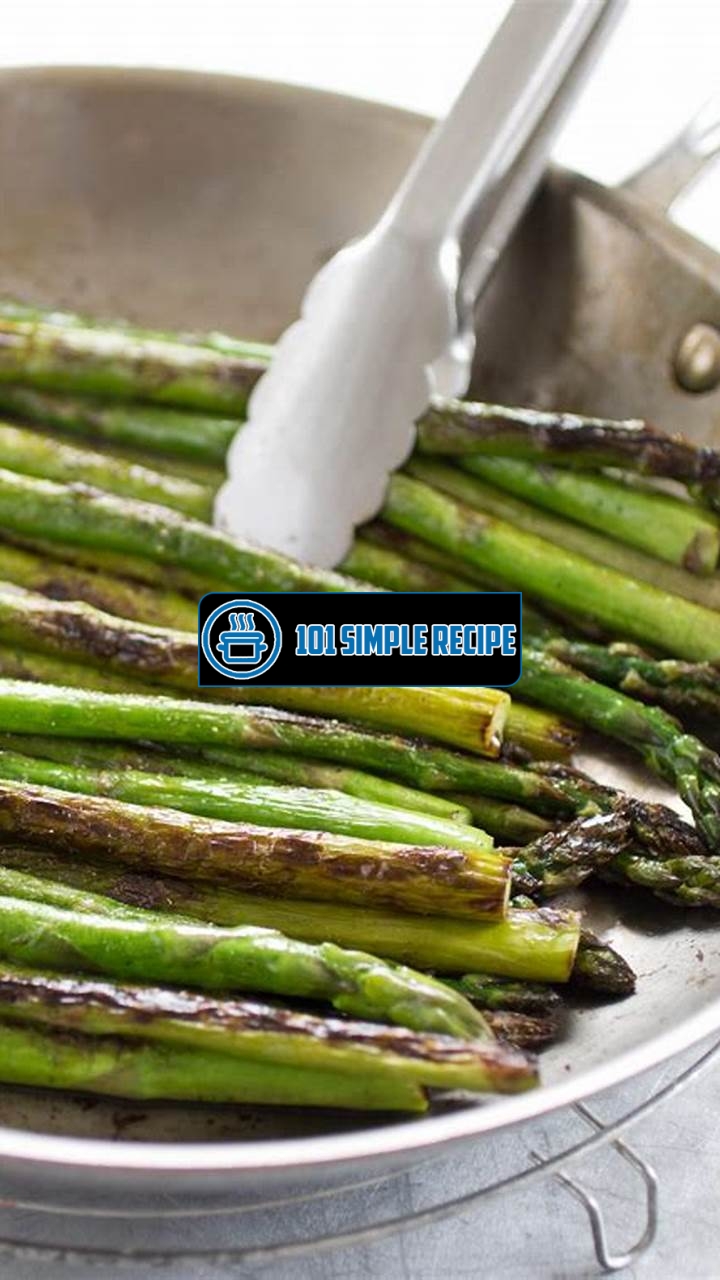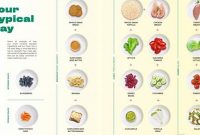Are you ready to take your asparagus cooking skills to the next level? Look no further! Mastering the art of cooking asparagus on the stove will elevate your culinary expertise and impress your taste buds. With its vibrant green color and distinct flavor, asparagus is a versatile vegetable that can be easily incorporated into various dishes. Whether you prefer it lightly steamed or sautéed to perfection, this article will guide you through the process, providing you with tips and tricks along the way. So, grab your apron, sharpen your knives, and let’s dive into the wonderful world of cooking asparagus on the stove. ️

Preparing Asparagus on the Stove
Discover the detailed process of cooking asparagus on the stove, bringing out its natural flavors and textures.
Choosing and Preparing Fresh Asparagus
When it comes to cooking asparagus on the stove, the first step is to ensure you have fresh and high-quality asparagus. Look for vibrant green stalks with firm tips. To choose the best asparagus, pay attention to the thickness of the stalks. Thinner stalks tend to be more tender and flavorful, while thicker ones have a more robust texture. Additionally, check for any signs of wilting or discoloration, as these indicate that the asparagus is past its prime.
Once you have chosen your asparagus, it’s important to properly prepare it before cooking. Start by rinsing the stalks under cold water to remove any dirt or residue. Then, trim off the woody ends by snapping them off or cutting about an inch from the bottom. This ensures that you’re left with the tender and delicious parts of the asparagus.
Blanching Asparagus for Optimal Cooking Results
Blanching is a cooking technique that involves briefly boiling the asparagus before finishing it off on the stove. This method helps to retain the vibrant green color of the asparagus and bring out its natural flavors.
To blanch the asparagus, bring a pot of salted water to a boil. Then, gently add the asparagus and cook for about 2-3 minutes, or until it becomes slightly tender. Once done, remove the asparagus from the boiling water and immediately transfer it to a bowl of ice water. This will stop the cooking process and maintain its crispness.
Sautéing Asparagus for a Quick and Flavorful Dish
Sautéing is a popular method for cooking asparagus on the stove as it allows for quick and even cooking. It also brings out the natural flavors of the asparagus while adding a delicious caramelized texture.
To sauté asparagus, heat a skillet over medium-high heat and add a drizzle of olive oil or butter. Once the oil is hot, carefully add the asparagus and season with salt and pepper, or your preferred seasonings. Toss the asparagus occasionally to ensure even cooking, and cook for about 5-7 minutes, or until it reaches your desired level of tenderness.
By mastering the art of cooking asparagus on the stove, you can enjoy this nutritious and versatile vegetable in a variety of delicious dishes. Whether you choose to blanch or sauté, follow these steps to bring out the best flavors and textures of asparagus.
Note: Remember to adjust the cooking time based on the thickness of the asparagus stalks and your personal preference for tenderness.
Health Benefits of Asparagus
Asparagus is not only a delicious vegetable but also a powerhouse of nutrients that can provide numerous health benefits. Adding asparagus to your diet can be a great way to boost your overall well-being. Let’s take a closer look at some of the key advantages of incorporating asparagus into your meals:
Rich Source of Vitamins and Minerals
Asparagus is packed with essential vitamins and minerals that play a crucial role in maintaining a healthy body. This vibrant green vegetable is a great source of vitamins A, C, E, and K. These vitamins contribute to the overall health of your body by strengthening your immune system, promoting good eyesight, improving skin health, and supporting blood clotting.
In addition to vitamins, asparagus is also rich in minerals such as potassium, folate, and chromium. Potassium helps maintain healthy blood pressure levels, folate is important for pregnant women as it aids in proper fetal development, and chromium assists in regulating blood sugar levels.
Promotes Digestive Health
Asparagus is rich in fiber, which plays a crucial role in maintaining a healthy digestive system. Fiber adds bulk to your stool, preventing constipation and promoting regular bowel movements. By including asparagus in your meals, you can support a healthy digestive tract and reduce the risk of gastrointestinal issues.
Moreover, asparagus contains a prebiotic called inulin, which acts as food for the beneficial bacteria in your gut. These bacteria contribute to a healthy gut microbiome and support optimal digestion, nutrient absorption, and immune function.
Supports Optimal Detoxification
Asparagus contains certain compounds and antioxidants that support optimal detoxification processes in the body. These include glutathione, a powerful antioxidant that helps eliminate harmful toxins from the body.
By incorporating asparagus into your diet, you can assist your liver in effectively breaking down and eliminating toxins, heavy metals, and other harmful substances. This can contribute to overall detoxification and help maintain a healthy body.
In conclusion, asparagus is not just a tasty vegetable but also a nutritional powerhouse. Its rich vitamin and mineral content, along with its digestive health and detoxification benefits, make it an excellent addition to your diet. So, why not master the art of cooking asparagus on the stove and start reaping its numerous health rewards?
Asparagus Recipes and Pairings
Discover delicious recipes and exciting ingredient combinations that complement asparagus cooked on the stove. Whether you are a foodie or simply enjoy experimenting in the kitchen, these recipes will elevate your asparagus game to new heights. Let’s explore three delightful recipes that will tantalize your taste buds and leave you craving for more.
Simple Garlic Parmesan Roasted Asparagus
Indulge in the delectable flavors of roasted asparagus seasoned with a touch of garlic and parmesan. This recipe is incredibly easy to prepare and requires minimal ingredients. Just picture the vibrant green asparagus spears, perfectly roasted to a tender yet slightly crisp texture, adorned with the aromatic notes of garlic and the nutty richness of parmesan cheese. A match made in culinary heaven!
To make this mouthwatering dish, you will need:
- Fresh asparagus spears
- Garlic cloves, minced
- Grated parmesan cheese
- Olive oil
- Salt and pepper to taste
Start by preheating your oven to 425°F (220°C). Meanwhile, trim the ends of the asparagus spears to remove the woody parts. Place the asparagus on a baking sheet, drizzle with olive oil, and sprinkle minced garlic, parmesan cheese, salt, and pepper over the top. Toss everything together to ensure each spear is coated in the flavorful mixture. Roast the asparagus in the preheated oven for about 12-15 minutes or until they are tender yet still slightly crisp.
Asparagus and Prosciutto Bundles with Balsamic Glaze
Take your asparagus to the next level by wrapping them with savory prosciutto and drizzling them with a sweet and tangy balsamic glaze. This elegant dish combines the earthy flavors of asparagus with the saltiness of prosciutto and the richness of balsamic glaze. The result? A symphony of flavors that will impress even the most discerning palates.
To create these delectable bundles, you will need:
- Fresh asparagus spears
- Thinly sliced prosciutto
- Balsamic glaze
- Olive oil
- Salt and pepper to taste
Start by blanching the asparagus in boiling water for about 1-2 minutes until they are slightly tender. Remove them from the water and immediately plunge them into ice water to halt the cooking process and maintain their vibrant green color. Wrap each asparagus spear with a slice of prosciutto and secure it with a toothpick. Place the bundles on a baking sheet, drizzle with olive oil, sprinkle with salt and pepper, and roast in a preheated oven at 400°F (200°C) for approximately 10-12 minutes. Once done, drizzle the bundles with balsamic glaze and serve them as an elegant appetizer or side dish.
Asparagus and Mushroom Stir-Fry with Soy Sauce
Experience the incredible umami flavors of stir-fried asparagus and mushrooms, elevated by the savory notes of soy sauce. This Asian-inspired dish is quick, easy, and bursts with the natural flavors of the ingredients. The slight crunch of the asparagus and the earthiness of the mushrooms perfectly complement the depth of soy sauce, resulting in a harmonious and satisfying dish that you’ll crave over and over again.
To prepare this delightful stir-fry, gather the following ingredients:
- Fresh asparagus spears
- Sliced mushrooms (such as button or shiitake)
- Garlic cloves, minced
- Soy sauce
- Sesame oil
- Salt and pepper to taste
Start by heating a tablespoon of sesame oil in a large skillet or wok over medium heat. Add the minced garlic and stir-fry for a minute until fragrant. Add the mushrooms and asparagus spears to the skillet and continue to stir-fry for about 4-6 minutes until the vegetables are tender-crisp. Pour in the soy sauce, season with salt and pepper, and cook for an additional 1-2 minutes. Serve this delightful stir-fry as a side dish or toss it with cooked noodles for a wholesome main course.
There you have it! Three incredible recipes that showcase the versatility of asparagus when cooked on the stove. Whether you prefer the simplicity of roasted asparagus, the elegance of prosciutto-wrapped bundles, or the umami richness of stir-fried asparagus and mushrooms, these recipes are sure to delight your taste buds and impress your guests. So fire up that stove and embark on a culinary adventure with asparagus as your guiding star! ✨
Asparagus Cooking Tips and Tricks
Mastering the art of cooking asparagus on the stove is a skill that can elevate your culinary repertoire. Whether you are a seasoned home cook or just starting out in the kitchen, these expert tips and tricks will ensure that your asparagus turns out perfectly every time. With a few simple guidelines, you can create a delicious and nutritious dish that will impress your family and friends.
Seasoning and Spices to Enhance Flavor
When cooking asparagus on the stove, it’s important to enhance its natural flavors with the right seasonings and spices. To add a burst of flavor, consider using garlic, lemon zest, or Parmesan cheese. These ingredients can be sprinkled over the asparagus during the cooking process to infuse it with a delightful taste. Additionally, a dash of salt and pepper can go a long way in bringing out the best in asparagus. Don’t be afraid to experiment with different combinations of seasonings to find your favorite.
The Ideal Cooking Time for Perfectly Cooked Asparagus
The cooking time is crucial when it comes to achieving perfectly cooked asparagus. To ensure that it retains its crispness and vibrant green color, blanching or sautéing are the preferred cooking methods. Blanching involves boiling the asparagus for a short period of time, typically 3-4 minutes, and then immediately transferring it to an ice bath to stop the cooking process. Sautéing, on the other hand, involves cooking the asparagus in a hot pan with a small amount of oil for approximately 5-7 minutes. Both methods result in tender and flavorful asparagus that is not overcooked.
Storing and Freezing Asparagus for Future Use
Knowing how to properly store and freeze asparagus can help you enjoy this delicious vegetable year-round. To store fresh asparagus, trim the ends of the stalks and place them upright in a container with about an inch of water. Cover the top with a plastic bag and refrigerate for up to a week. If you have an abundance of asparagus and want to preserve it for longer, freezing is a great option. Simply blanch the asparagus for 2-3 minutes, then transfer it to an ice bath to cool. Once cooled, pat dry and place in freezer-safe bags or containers. Frozen asparagus can be stored for up to 8-12 months.
By following these expert tips and tricks, you can master the art of cooking asparagus on the stove. Experiment with seasonings and spices to enhance the flavor profile, and pay attention to the ideal cooking time for perfectly cooked asparagus. Don’t forget to store and freeze any leftover asparagus for future use. With a little practice, you’ll be able to create mouthwatering asparagus dishes that will impress even the most discerning palates.
Fun Facts and History of Asparagus
Delve into the fascinating world of asparagus, from its ancient origins to interesting trivia about this versatile vegetable.
Asparagus in Ancient Egyptian and Roman Cuisine
Asparagus holds a long and prestigious history, with its consumption dating back thousands of years. Ancient Egyptians and Romans were among the first civilizations to recognize its delectable taste and culinary potential.
In Ancient Egypt, asparagus was highly regarded as a luxury food reserved for royalty and the elite. Historians believe that the vegetable originated in the eastern Mediterranean region and was cultivated along the Nile River. The Egyptians revered asparagus for its health benefits, believing it had medicinal properties, including diuretic and aphrodisiac qualities.
The Romans, known for their sophisticated gastronomy, also embraced asparagus as a delicacy. It is said that Emperor Augustus created special ships designed solely for the purpose of transporting asparagus. The Romans enjoyed asparagus in various forms, including steamed, boiled, and grilled. They even froze the vegetable for consumption during the winter months.
Interestingly, the Romans believed that asparagus was not only a delicious treat but also possessed medicinal properties. They believed it had diuretic effects and could alleviate toothaches, improve digestion, and even prevent bee stings.
The Etymology of the Word “Asparagus”
The term “asparagus” originates from the Greek word “asparagus,” which means “sprout” or “shoot.” This name aptly captures the nature of the vegetable, as it is the young shoot of a perennial plant.
Throughout ancient history, asparagus was culinary and medicinal. Its popularity spread across Europe and the Middle East, leading to various names for this flavorful vegetable in different languages. For instance, in French, it is called “asperge,” while the Spanish refer to it as “espárrago.” Regardless of the language, asparagus has managed to retain its esteemed reputation and universal appeal.
Asparagus Festivals and Cultivating Regions Around the World
Asparagus has become such a beloved vegetable that people around the world celebrate it through festivals and events. These gatherings not only showcase the versatile ways to prepare and enjoy asparagus but also serve as a testament to its cultural significance.
One of the most prominent asparagus festivals takes place in Stockton, California, where the annual Asparagus Festival attracts thousands of visitors. This lively event features asparagus-inspired dishes, cooking competitions, live music, and even a beauty pageant.
Other regions known for their asparagus cultivation and festivals include the Vale of Evesham in England, celebrating with their Asparagus Festival, and the Schwetzingen Asparagus Festival in Germany.
Asparagus thrives in different parts of the world, thanks to its adaptable nature. Major cultivating regions include France, Germany, Italy, Mexico, Peru, and California in the United States.
Fun Fact: Did you know that asparagus belongs to the same family as onions, garlic, and leeks? It is part of the lily family, scientifically known as Asparagaceae.
The history and appeal of asparagus continue to captivate culinary enthusiasts worldwide. Whether enjoyed in ancient Egyptian and Roman cuisines or celebrated at modern-day festivals, this versatile vegetable has truly stood the test of time.
Thank you for taking the time to read our article about cooking asparagus on the stove. We hope you found the information helpful and inspiring for your next culinary adventure. If you’re looking for more delicious recipes and cooking tips, be sure to visit our website again soon. We’re constantly updating our content to provide you with fresh and exciting ideas to enhance your cooking skills. Until next time, happy cooking!
Frequently Asked Questions
Here are some frequently asked questions about cooking asparagus on the stove:
| No. | Questions | Answers |
|---|---|---|
| 1. | How do I prepare asparagus for cooking on the stove? | To prepare asparagus for cooking on the stove, start by washing the spears under cold water and trimming off the tough ends. You can also peel the lower portion of the asparagus if desired. |
| 2. | What is the best method for cooking asparagus on the stove? | The best method for cooking asparagus on the stove is to blanch it in boiling water for a few minutes, then transfer it to a hot skillet with some olive oil or butter and cook until tender. This method helps to retain the vibrant green color and crisp texture of the asparagus. |
| 3. | Can I season asparagus while cooking it on the stove? | Absolutely! Seasoning asparagus with salt, pepper, and other herbs and spices can enhance its flavor. You can add the seasoning during the blanching process or sprinkle it on the asparagus while it’s cooking in the skillet. |
| 4. | How long does it take to cook asparagus on the stove? | The cooking time for asparagus on the stove can vary depending on the thickness of the spears. Generally, it takes about 3-5 minutes to blanch the asparagus and another 5-7 minutes to cook it in the skillet until tender. |
| 5. | What are some serving suggestions for stove-cooked asparagus? | Stove-cooked asparagus can be served as a side dish alongside grilled meats, roasted chicken, or fish. It also makes a great addition to pasta dishes, salads, and risottos. Sprinkle some Parmesan cheese or squeeze a lemon over the cooked asparagus for extra flavor. |
| 6. | Can I store leftover stove-cooked asparagus? | Yes, you can store leftover stove-cooked asparagus in an airtight container in the refrigerator for up to 3-4 days. Reheat it gently in the microwave or enjoy it cold in salads and wraps. |
Closing Thoughts
We hope this article has inspired you to try cooking asparagus on the stove. It’s a simple and delicious way to enjoy this nutritious vegetable. Whether you’re looking for a quick and healthy side dish or a versatile ingredient to include in your favorite recipes, stove-cooked asparagus is a great choice. Don’t forget to visit our website again for more cooking inspiration and tips. Happy cooking!
Jump to Recipe
Asparagus on the Stove

Learn how to cook delicious asparagus on the stove with this easy recipe. Perfect as a side dish or ingredient for various recipes. Get cooking today!
- 1 bunch of asparagus
- 1 tablespoon olive oil
- Salt and pepper to taste
- Wash the asparagus under cold water and trim off the tough ends.
- Bring a pot of salted water to a boil and blanch the asparagus for 3-5 minutes, until bright green and slightly tender.
- Heat olive oil in a skillet over medium-high heat. Add the blanched asparagus and season with salt and pepper.
- Cook the asparagus for 5-7 minutes, tossing occasionally, until it is tender and slightly charred.
- Remove from heat and serve hot as a side dish or use in your favorite recipes.






